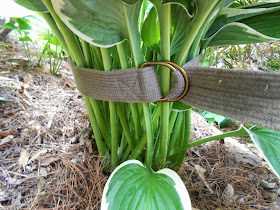When I originally purchased the stand it had more of a brushed nickle finish on it which was not the look I was going for. Here it is before I painted it:
A closer look at the base:
What I wanted was the look of aged copper-but I wanted it to be easy and cheap. So I went to my favorite craft and DIY tool-spray paint. This project is sooo easy and it is cheap too (an added bonus).
For this project you will need:
1. Object to paint
2. Sandpaper
3. Spray paint-I used Rustoleum in Hammered Copper, Rustoleum 2x in Expresso and Rustoleum 2x in Seaside (if you want more of a green patina chose a greener spray paint such as Lagoon)
4. 2 dry paint brushes
5. A piece of cardboard or plastic to work on
6. A spray sealer in a matte finish
That's all you need!
Here are the steps to create your faux patina:
1. Take a piece of sandpaper and rough up the surface of the project-it only needs to be scratched up a little-don't worry about sanding it down completely.
2. Take the copper spray paint and apply it to your piece making sure to cover all the nooks and crannies. After it is thoroughly covered let it dry completely. You need to do this 3 times (3 coats of copper) and then let it dry completely between coats.
3. When the copper paint has dried on your piece it is time for paint number 2-expresso. Get your brush ready-leave it dry-and grab the can of paint. Spray a small puddle on the piece of cardboard:
Dab your brush in the little puddle of paint then dab and brush it on the piece-make sure to grab only a little paint at a time. You want some of the copper to show through.
Just keep dabbing and brushing until your piece looks similar to this:
Here is a blurry closeup:
Notice how I didn't totally cover the copper-just covered it up here and there. Let the brown dry completely on the object before moving on to the next step.
4. Grab your second paint brush and your blue or green spray paint. Spray a small puddle on to the cardboard or plastic (just like in step 3) and dab your brush in it:
Now start dabbing and brushing your project with the blue/green paint like this:
Just continue to add blue/green in random areas-make sure not to cover the brown and copper entirely. Note-you will have to keep loading your brush with paint-it can dry pretty quickly. Just spray a little at a time on the cardboard.
After you cover the piece in the blue/green color you need to let it dry completely.
5. Grab the brown brush and paint again-now is the time we tone down some of the blue/green paint. Spray a small puddle on the cardboard again and dab the brush in it. Then dab and brush on to tone down some of the blue areas:
After you have added as much brown as you wanted let it dry completely.
6. Seal with a Matte spray paint sealer.
Here is a pic of the completed project:
This patina project was easy and cheap! Most of the time it took was spent waiting for the paint to dry:-) I hope you try this project out-it can be used on anything you intend on spray painting-even planters or pots!
Until next time-Happy Planting!
Rhonda




































































